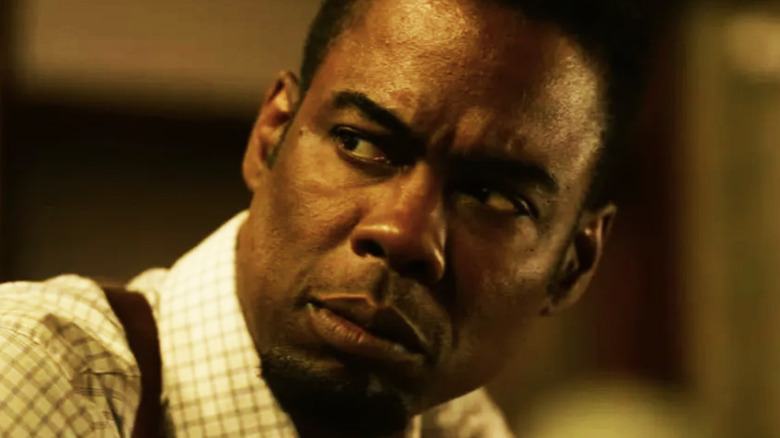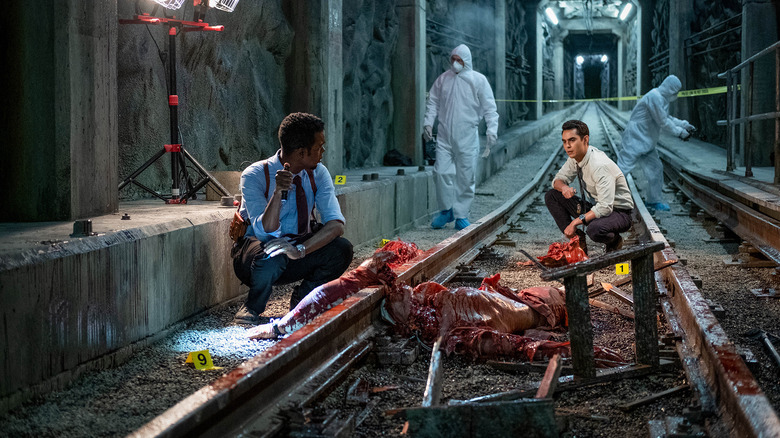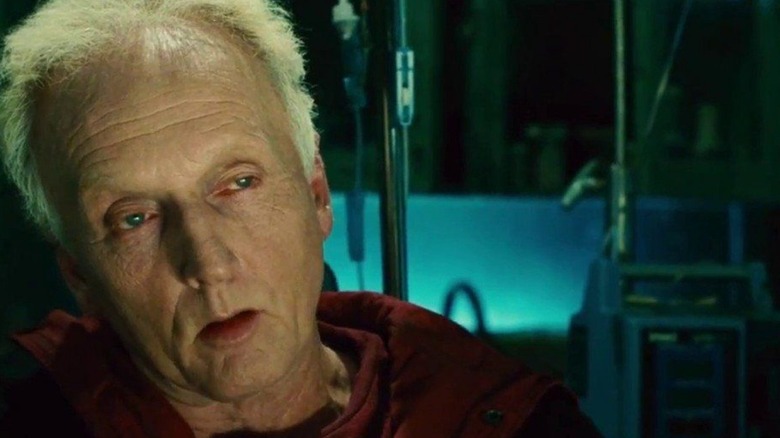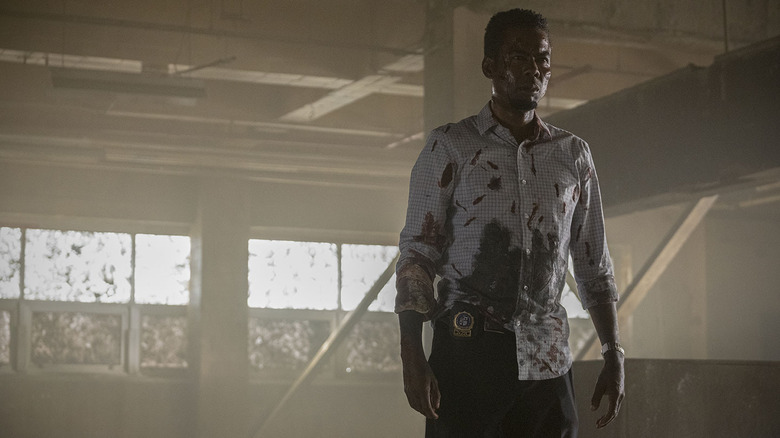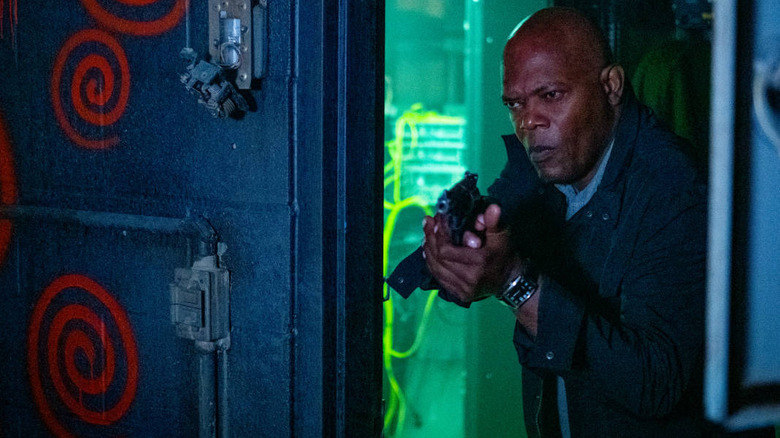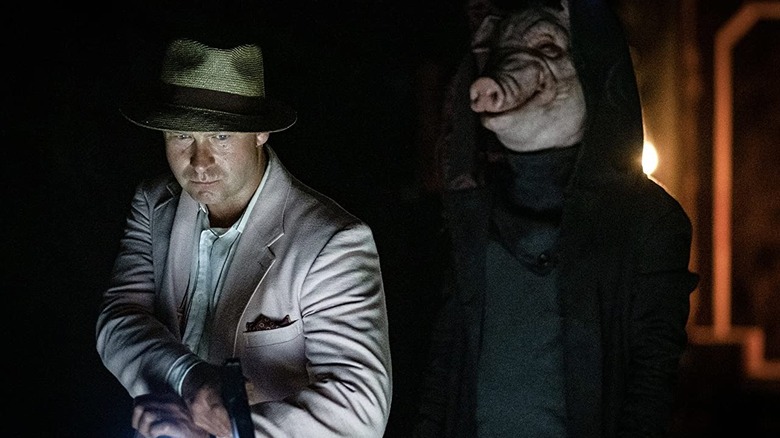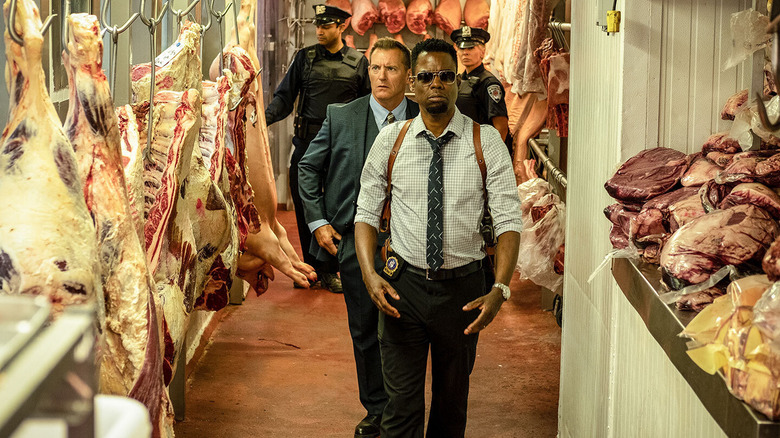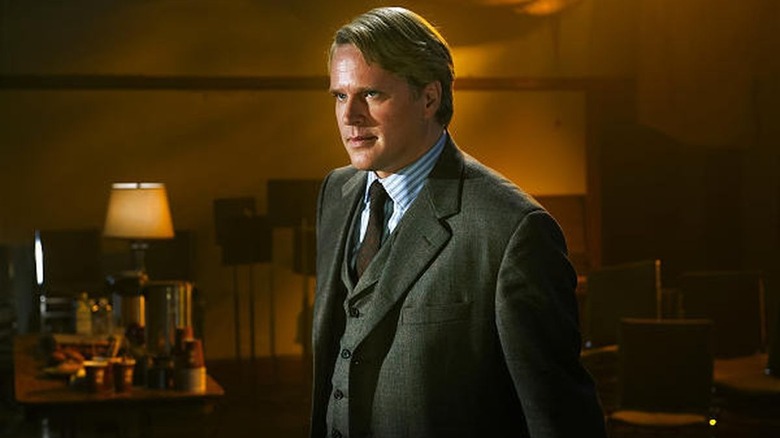The Ending Of Spiral: From The Book Of Saw Explained
This article contains spoilers for "Spiral: From the Book of Saw."
"Spiral: From the Book of Saw" may have new characters, new lore, and a brand new killer, but make no mistake: It's still a "Saw" movie through and through. Like its predecessors, it's full of gruesome traps, horrifically over-the-top gore, and, most importantly, a big twist ending that ties all of the film's disparate pieces together — and sets up more adventures in the future.
In fact, the ending of "Spiral" may be more important than that of any "Saw" movie that came before. While previous "Saw" films resemble traditional slasher flicks in their structure, in that the main draw is seeing whether Jigsaw's victims survive their tests, "Spiral" is a whodunit. Sure, there are moments of shocking violence and incredible tension, but the story focuses on Detective Zeke Banks, played by Chris Rock, and his investigation into the Jigsaw copycat who's picking off his comrades in the police force one by one.
In mystery stories like this one, everything comes down to one question: Who committed the crimes, and why? While "Spiral" gives a satisfying, if not entirely surprising, answer, there's also a lot more going on in its ending than you might realize. If you've already seen "Spiral" (and, if you haven't, beware — there are some major spoilers ahead), here's some of the stuff you might have missed.
It was (spoiler) all along
The biggest reveal at the end of "Spiral" is also the most obvious: the identity of the serial killer who's been hunting down the members of the South Metro police precinct. As savvy viewers probably guessed, the killer is none other than Zeke's new partner, William Schenk (Max Minghella). As William lays out in a "Scooby Doo"-esque monologue at the end of the film, he is the son of the witness who Zeke's former partner, Pete Dunleavy, killed in order to protect a dirty cop.
Ever since that fateful night, Schenk — which isn't his real name, by the way — has been planning his revenge, and he wants Zeke's help. As Zeke proved by turning in Pete and ruining both of their careers, he's one of the few honest cops in a precinct that's rife with corruption. By targeting dirty cops and forcing them to make amends for their misdeeds (usually by sacrificing one of their body parts), Schenk hopes to scare the other officers into going straight. If not, well, he'll be there to punish them.
While Schenk thinks Zeke is the ideal partner for his depraved scheme, the veteran detective disagrees. So of course, Schenk has created a trap that forces Zeke to make a near-impossible choice. Zeke can use the single bullet left in his gun to shoot a target that stops his captured father (Samuel L. Jackson) from bleeding out, or he can shoot Schenk. Zeke chooses to save his dad. But as Schenk gets away, a SWAT team bursts into the room. Thanks to Zeke's infernal machine, they mistakenly see the elder Banks as a threat, and kill him anyway.
The clues are all there, if you're looking
During his big reveal, Schenk lays out exactly how he manipulated Zeke and managed to escape detection for so long. He lured Zeke's father, Marcus, to an abandoned location by borrowing Zeke's phone. He faked his own death by copying his tattoo onto a corpse. He pretended to have a wife and an infant son in order to divert Zeke's suspicion. He even dropped little hints during the investigation: "Your dad is the reason for all of this. He's why I want to do this in the first place," Schenk notes near the beginning, with Zeke none the wiser.
There are other clues, though, which "Spiral" doesn't explicitly lay out. Schenk's tattoo says "Charlie," which he passes off as the name of his (fictional) son, but which is also the first name of the man Dunleavy murdered. In a movie like this, that's not a coincidence. The killer also wears a pig mask. Given that "pig" is a derogatory term for a cop, Zeke maybe should have started looking for suspects inside the precinct a little earlier.
Finally, the killer targets police officers with skeletons in their closets, and reveals their sins via videotape. When Zeke visits the scene of Schenk's supposed murder, however, the audio track fades out before we can hear what the tape has to say about the young detective's past, hinting that it's not important — or, as it turns out, is completely fictional.
The philosophy behind the spiral
"Spiral: From the Book of Saw" is pretty specific about why Schenk commits murder, but a little less clear on why he decides to become a Jigsaw copycat in particular. And make no mistake, Schenk rips off John Kramer's playbook almost completely. He subjects his victims to potentially deadly, and always bloody, tests. He taunts them via video tape. He uses puppets to create fear, and he wears the same kind of pig mask that Jigsaw and his accomplices used during their murder sprees.
Both "Spiral" and Schenk himself give an explanation during the film's big reveal scene. "John Kramer was right," Schenk says. "The spiral — a symbol of change, evolution, progress." That reasoning is a little confusing, though. If you haven't seen another "Saw" movie, you may not know what Kramer's philosophy is. If you have, you realize Schenk's explanation only sort of holds up.
As revealed in "Saw II," John Kramer tried to kill himself after he was diagnosed with cancer. He failed, but emerged from the experience with a newfound love for life, and vowed to share that revelation with others. He ultimately decided to spread his message by kidnapping people who were wasting their gifts and taking life for granted, then torturing them until they either died or proved their desire to live, but his goal — at least in his mind — was noble.
That's not quite the same as what Schenk's trying to do, which is scare people into behaving better. The spiral was never one of Kramer's major symbols, either. Still, both Schenk and Kramer were trying to transform their victims, and spirals are traditionally associated with change, so it kind of works. Also, Schenk is a psychopath. Logic isn't really his strong suit.
It's a Saw-worthy ending anyway
Even if Schenk's interpretation of Kramer's philosophy is muddled, the final scene in "Spiral" is "Saw" through and through. For most of its runtime, "Spiral" has its own tone. The traps are shot and edited like the murder scenes in "Saw" and its sequels, but the rest of the film is closer to a police procedural or dark crime drama than the torture porn vibe that defines "Saw" and its imitators.
In the end, though, "Spiral" finally becomes a "Saw" movie. Typically, "Saw" finales share a number of the same elements. There's always some big twist or reveal, like the dead body in "Saw" not being dead at all, or the unmasking of one of John Kramer's many accomplices. The most emotionally resonant death is usually saved for the end. The hero finds a new low — sometimes while facing down his or her imminent demise — while the bad guy gets away.
The big climax of "Spiral" has all of those: William Schenk raising a finger to his lips as the elevator door closes and he escapes to safety; the revelation that Zeke's father Marcus isn't actually safe at all, as the machine that he's strapped to lifts him into the air and begins raising his arm, pointing a rifle at the door; Marcus' death as the SWAT team bursts into the room; and a close-up on Chris Rock's tortured face. You can even hear "Hello Zepp," the "Saw" franchise's ominous theme song, playing just before the credits roll.
For most of its runtime, "Spiral" shies away from the "Saw" formula, only to embrace it at the very end. For longtime fans, it should work very, very well.
As per Saw tradition, it's all a matter of time
The "Saw" franchise likes to play fast and loose with its timeline. The movies make liberal use of flashbacks to fill in pieces of backstory, or to show us grisly deaths that we missed the first time they happened. Messing with the timeline also leads to some of the "Saw" series' biggest reveals. The twist at the end of "Saw IV," for example, is that the prologue, in which Detective Hoffman examines John Kramer's body, actually takes place after the rest of the movie — it's a flash-forward, which completely changes its significance in the story. "Jigsaw" makes viewers think John Kramer has miraculously survived death, only to reveal that his scenes took place years earlier.
"Spiral" plays similar tricks. Similar to previous "Saw" films, flashbacks reveal what happened earlier in Zeke's career, and flesh out the specifics of Detective Fitch's demise. There's also a little timeline fun that's used to deceive the audience, but that's not clear until the end of the film. Fairly early in "Spiral," Marcus Banks goes missing. He won't return phone calls, and he's not at his apartment when Zeke stops by. That's why it's a little surprising when he suddenly shows up two-thirds of the way through, investigating an old soap factory, right after Zeke is captured.
As the end of the movie reveals, this is a fake-out. The scene depicting Marcus' capture actually comes sometime between the time that Schenk borrows Zeke's phone and Zeke's first visit to Marcus' apartment, right around the time that Fitch dies. In terms of setting up a fair mystery, yeah, it's kind of cheating — but misdirects like that are also time-honored "Saw' traditions. You're just going to have to roll with it.
The moral of this story is...
The "Saw" franchise has gotten political before. "Saw VI" kicks off with a trap punishing two subprime mortgage lenders — remember, this was 2009 — before jumping into a story about the inequalities of the for-profit insurance industry. As far as political satire goes, it's pretty clunky, but it's there.
Similarly, "Spiral" flirts with social commentary, too. The entire story hinges on police corruption, particularly police brutality. Zeke is ostracized because he tattles on an officer who killed a witness in order to cover up a different event, in which an officer threw someone off of a rooftop. Fitch is killed because he shot a suspect who talked back to him. Marcus and his successor, Angie, are marked for death as the masterminds behind Article 8, a police policy that lowered crime rates at the cost of civilians' lives.
In the age of George Floyd and Black Lives Matter, the real-world parallels in "Spiral" are impossible to ignore, especially with a Black man as the lead. However, "Spiral" never fully commits to its anti-police brutality message. None of the police's victims are people of color. Some of the crooked cops, like Marcus, are sympathetic. Schenk condemns the entire policing system, but then clarifies that he's only targeting "bad" cops, implying that plenty of them are okay — and he's the villain! Ultimately, we're not supposed to agree with him.
The main lesson in "Spiral" seems to be that there's no way to be a "good" police officer. Either you're corrupt and violent, or you end up like Zeke, who's despised by his peers and loses everything he has. There's something interesting there — it's too bad that the movie muddles the message, and never pushes its moral stance all the way.
In the end, more than a few questions remain
It may seem like "Spiral" ties everything together in the end. It doesn't. Yes, all of the major questions are answered, the fate of the main characters is revealed (aside from William and Zeke, they're basically all dead), and the murderer is identified.
However, when you start to think about it, there's quite a bit that doesn't hang together. One major clue comes in the form of a paint bottle from the Constantine Hobby Shop, a store that Zeke and Marcus visited when Zeke was still a child. That's something William shouldn't know about. In order to access the police station's security footage, a potential hacker needs a badge and a password. When Zeke checks the logs, the evidence points to Dunleavy. Schenk could probably get Dunleavy's badge, but his password? That seems iffier.
We also never learn who Dunleavy was trying to protect when he murdered Charlie Emmerson, how Schenk was able to manipulate the system so precisely that he ended up as Zeke's partner, how he managed to set up an elaborate trap in the precinct's cold case room without being spotted, or what exactly Article 8 entails. There's also a little bit of timeline confusion. Early on, Zeke says that he reported Dunleavy's crime 12 years prior. Later, William says his father was murdered 15 years earlier. Either Zeke sat on the information he had for three years — which seems unlikely — or something else is going on. Either way, not all of the pieces fit.
Where does Spiral go from here?
We already know we're getting another "Saw" movie. "Saw X" was greenlit well before "Spiral" debuted, and while Chris Rock notes that a direct "Spiral" sequel depends on how this one does at the box office, he's ready to return if asked.
With that in mind, it's pretty easy to see what a sequel might explore. As the credits roll, William Schenk is free to cause more mayhem. While Zeke knows his identity, it's clear that his mission to violently reform the police still has a long way to go. Jigsaw's legacy still looms over the city too. After all, Schenk is the second Jigsaw copycat to cause havoc. Chances are, there's going to be a third.
That's not even counting all of Jigsaw's accomplices, including Lawrence Gordon, who as of the end of "Saw 3D: The Final Chapter" is still at large. If the studio wants to pay Cary Elwes to return and face off against Chris Rock, we wouldn't turn that down. It's possible that there are other Jigsaw proteges lurking out there, too. He does have a bunch of 'em.
As far as Zeke's personal arc is concerned, there's plenty to mine there, too. His soon-to-be ex-wife only had one scene in "Spiral," but could play a bigger part in future installments ("Saw" movies love to toy with the heroes' loved ones). He didn't hit rock bottom until the very end of "Spiral," so seeing how someone comes back from a loss like that could be very compelling. As a franchise, "Saw" is famous for playing the long game. When it comes to the world of "Spiral," we're probably just getting started.
